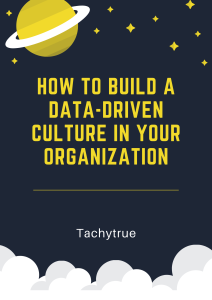How to Build a Data-Driven Culture in Your Organization
Data science, data transfer, digital world, networking, Project management, Technology, Uncategorized, webIntroduction
In today’s hyper-competitive business landscape, data is no longer just a byproduct of operations; it’s a strategic asset that can drive innovation, improve decision-making, and unlock unprecedented growth. However, simply collecting data isn’t enough. To truly capitalize on its potential, organizations must cultivate a data-driven culture – a mindset and set of practices where data informs every decision, from strategic planning to day-to-day operations. Building such a culture is a transformative journey, requiring commitment, investment, and a clear understanding of the key elements involved. This article outlines a comprehensive approach to building a data-driven culture within your organization.

1. Leadership Buy-in: Setting the Tone from the Top
The foundation of any successful cultural transformation is leadership buy-in. Leaders must champion the data-driven approach, not just with words, but with tangible actions. This includes:
Demonstrating Commitment: Leaders must visibly demonstrate their belief in the power of data by actively using data to inform their own decisions.
Investing in Resources: Building a data-driven culture requires investment in the necessary tools, technologies, and talent. Leaders must allocate budget and resources to support data collection, analysis, and infrastructure.
Communicating the Vision: Leaders must clearly articulate the vision for a data-driven organization and communicate the benefits to all employees. This helps create a shared understanding and buy-in across the organization.
Empowering Data Champions: Identify and empower data champions within different departments. These individuals can act as advocates for data-driven decision-making and help spread the culture throughout the organization.
2. Data Accessibility: Democratizing Data Across the Organization
Data is only valuable if it’s accessible to those who need it. Democratizing data involves:
Breaking Down Data Silos: Data often resides in different departments and systems, creating silos that hinder collaboration and knowledge sharing. Integrate data from various sources into a centralized data warehouse or data lake to make it accessible to everyone.
Providing Self-Service Tools: Equip employees with self-service data analytics tools that allow them to access and analyze data without needing specialized technical skills. This empowers them to make data-informed decisions in their respective roles.
Ensuring Data Quality: Data quality is paramount. Invest in data governance processes and tools to ensure that data is accurate, reliable, and consistent. Garbage in, garbage out – if the data is flawed, the insights derived from it will be flawed as well.
Establishing Data Governance: Implement clear data governance policies and procedures to ensure data security, privacy, and compliance. This builds trust in the data and encourages its responsible use.
3. Data Literacy: Empowering Employees with Data Skills
Data accessibility is only half the battle. Employees must also have the skills to interpret and use data effectively. This requires:
Training and Development: Provide training programs to enhance data literacy across the organization. Focus on teaching employees how to interpret data, identify trends, and draw meaningful conclusions.
Promoting Data Fluency: Encourage employees to become comfortable working with data. This can be achieved through hands-on workshops, online courses, and mentorship programs.
Creating a Data-Driven Language: Encourage the use of data-driven language in meetings and discussions. This reinforces the importance of data in decision-making.
Building a Community of Practice: Create a community of practice where employees can share their data-related experiences and learn from each other.
4. Data-Informed Decision Making: Integrating Data into Everyday Processes
The ultimate goal of building a data-driven culture is to integrate data into every decision-making process. This involves:
Defining Key Metrics: Identify the key metrics that are relevant to each department and the organization as a whole. These metrics should be aligned with business objectives.
Encouraging Experimentation: Foster a culture of experimentation where employees are encouraged to test new ideas and use data to measure the results. This promotes innovation and continuous improvement.
5. Culture of Curiosity: Fostering a Data-Seeking Mindset
A data-driven culture is characterized by a culture of curiosity, where employees are constantly seeking answers and insights from data. This requires:
Encouraging Questioning: Encourage employees to ask questions and challenge assumptions. Data can help answer these questions and validate or disprove assumptions.
Promoting Data Exploration: Create opportunities for employees to explore data and discover new insights. This can be achieved through hackathons, data challenges, and other initiatives.
Celebrating Data-Driven Successes: Publicly recognize and celebrate data-driven successes to reinforce the value of data and encourage its use.
Creating a Safe Space for Failure: Encourage experimentation and learning from failures. Not every data-driven initiative will be successful, but it’s important to learn from mistakes and iterate.
6. Continuous Improvement: Adapting and Evolving
Building a data-driven culture is an ongoing process. It requires continuous improvement and adaptation. This involves:
Monitoring Progress: Track progress toward building a data-driven culture and identify areas for improvement.
Gathering Feedback: Solicit feedback from employees on their experiences with data and use this feedback to make adjustments.
Staying Up-to-Date: Keep up with the latest trends in data science and analytics and incorporate new tools and techniques as needed.
Embracing Change: Be prepared to adapt and evolve as the organization’s needs and priorities change.
Building a data-driven culture is not a quick fix; it’s a long-term commitment. However, the benefits are significant. Organizations that embrace data-driven decision-making are more likely to be innovative, competitive, and successful in the long run. By following the steps outlined in this article, you can lay the foundation for a thriving data-driven culture within your organization, unlocking the full potential of your data and driving sustainable growth.
